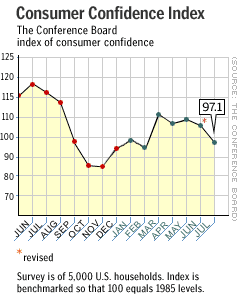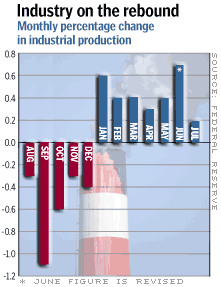NEW YORK (CNN/Money) -
President Bush, Alan Greenspan and economists keep saying that the U.S. economy will probably be fine, that recent weak data are just bumps in the road and that everything will almost certainly be hunky-dory by the end of the year.
But it sure has been hard to believe lately.
"I think the economy's momentum is still upward, but the data that have come out in the past month have weakened my confidence in that prediction," Bill Cheney, chief economist at John Hancock Financial Services, told CNNfn's CNNmoney Morning program. "I haven't changed my forecast, but I've become a lot less certain about it."
Here are some recent signs of trouble, which so far have been explained away by economists as being no big deal. Though most economists don't believe it's likely, they'll admit they have to make room for the outside chance that these could be early warnings of a dreaded "double-dip" back into recession.
Consumer confidence
Reuters reported Friday that the University of Michigan's index of consumer sentiment fell in August, confounding the expectations of Cheney and other economists for a rise. In a conversation with CNN/Money after that report, Cheney put the best possible face on the data, as other economists did.

"I don't really see this as down; it's really flat," Cheney said. "We're still at a level well above the post-Sept. 11 low; and so long as it doesn't trend downward, I'm comfortable with the idea that consumer spending is going to hang in there."
But the report followed a more dramatic drop in July of another closely watched confidence index, that of the Conference Board, a private research firm.
Consumer spending is critical to the broader economy because it makes up about two-thirds of total U.S. gross domestic product (GDP), which grew at a paltry 1.1 percent rate in the second quarter.
A combination of 11 Federal Reserve interest-rate cuts, fiscal stimulus provided by President Bush and Congress and incentives offered by automakers and other industries helped keep consumers spending during a recession that likely began in March 2001.
But prolonged weakness in the stock market, worsened in recent months by fears about the reliability of corporate accounting, has partially reversed the "wealth effect" of higher stock prices in the late 1990s while sapping many Americans' retirement savings.
"Up until 2000, households in the post-War period had never experienced a decline in their net worth on a year-end to year-end basis," said Paul Kasriel, economist at Northern Trust Co. "But they did in 2000, they did in 2001, and they're on course for it again in 2002."
If consumers start socking away more money to repair some of the damage done to their balance sheets and 401(k) plans, that means they'll be spending less, making the threat of a double dip more real.
Housing market
Another boost to consumer spending during the recession was a red-hot housing market, driven by rock-bottom mortgage rates. Homeowners were able to offset some of their stock-market losses by watching the values of their homes rise, they were able to refinance their mortgages to take advantage of lower rates and make lower payments, and they were able to tap into some of their newfound equity by borrowing against it.
| |
 Related stories
Related stories
| |
| | |
| | |
|
Observers have long fretted that the housing market was in a bubble that was set to pop like the Nasdaq stock bubble, leaving homeowners soaked -- though most economists have dismissed such fears, saying housing inventories are low, meaning prices aren't artificially inflated.
And though starts of new home construction fell in July for the second straight month, the Commerce Department reported Friday, economists pointed out that the housing market is merely pulling back from a blistering pace earlier this year.
"Forget the decline from the June pace. What is important is the level of activity, and that is extraordinarily high," said Joel Naroff, president and chief economist of Naroff Economic Advisors in Holland, Pa. "This market is showing no sign of weakness. With mortgage rates so low, it is no wonder that people are still out there buying homes. And with demand strong, construction is not going to fail."
Job market
The labor market is more crucial to consumer confidence than the housing market or the stock market, and recent signs there have been mixed, at best.
On the positive side, the number of new weekly claims for unemployment benefits has been mostly falling and has been below the benchmark 400,000 level for 10 out of the past 11 weeks.
And the unemployment rate, which has been hovering at about 5.9 percent for several months, is much lower than it was during previous recessions.
On the other hand, ,job growth has been anemic at best, with employers reluctant to hire new workers until they're sure demand for their products will rise enough to justify the greater production that would require more workers.
"We will see more bad news on the employment front," said Anthony Chan, chief economist at Banc One Investment Advisors. "We see unemployment going to 6.1 percent or 6.2 percent before it's over; no way are we going to see that coming down while we're creating so few jobs."
Manufacturing
The Labor Department, in its report on July unemployment, noted that the average number of hours worked per week by non-supervisory workers on non-farm payrolls dropped to 34 hours from 34.3 -- the first decline since October 2001 -- while manufacturing hours fell to 40.7 from 41.1, the biggest drop since December 2000.

That bad news helped reinforce a report from the Institute for Supply Management that its closely watched index of manufacturing activity slowed to a crawl in July, hovering barely above 50, a level that indicates expansion in the sector.
Economists were somewhat cheered by Thursday's report that the Fed's index of industrial production grew in July, saying it was a hopeful sign that businesses had not been too spooked by a brutal stock-market selloff.
"Part of the real story here is that, through July, producers were still getting more output, with fewer labor hours put in," said Ken Goldstein, economist at the Conference Board. "Productivity in the third quarter is probably going to be stronger than in the second quarter, confirming the idea that, while the stock market's not in good shape, the overall economy's not that bad."
Just hours later, however, the Philadelphia Federal Reserve Bank reported that its index of manufacturing activity, covering only Pennsylvania, New Jersey and Delaware, had fallen unexpectedly in July, putting the strength of the manufacturing sector back into doubt.
"The big question now is whether the ISM survey will follow the Philly down and dip below 50," Ian Shepherdson, chief U.S. economist at High Frequency Economics Ltd., said in a note.
Of course, Fed policy makers had many of these factors in mind when they decided earlier this week to leave their target for short-term interest rates alone and said they were still optimistic that the economy would start to grow again this year.
The x-factor in all of this is the possibility of another terror attack, a war with Iraq or other unexpected shocks to consumer confidence.
"If an event were to occur that would cause consumers to raise the savings rate and cut back on spending, even for a short period of time, it's conceivable that we'd get two or three months in which the economy would contract," said Robert Goodman, chief economist at Putnam Investments, adding, "1.1 percent GDP growth is little more than a rounding error -- it doesn't take much to throw that into negative territory."

|

